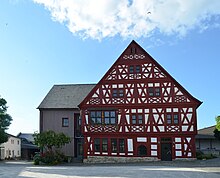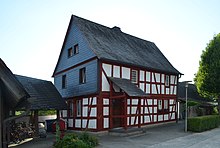Gnadenthal Monastery (Hesse)
The former Cistercian monastery Gnadenthal is the center of the ecumenical community Jesus Brotherhood . The settlement belongs to the municipality of Hünstelden in the Limburg-Weilburg district of Hesse and is located in the valley of the Wörsbach . The monastery church is the official cycle path church and is located on the Ems and Wörsbachtal cycle tour.
history
The monastery
On November 30, 1235 dated a deed in which the Cistercian nuns of the monastery Heilsbruck from unrelated Edelfreien Peter von Dehrn and Kuno von Reifenberg received and their women goods for the foundation of their monastery. In it the order received goods in Lindenholzhausen and Dauborn as well as the patronage of the church in Lindenholzhausen, further possessions and rights in Lindenholzhausen followed quickly as endowments from other nobles. Since the Heilsbruck monastery was only legally valid in 1232, Gnadenthal cannot have been founded before this year.
The foundation was primarily intended to provide for the daughters of the founders. The size of the convent for this phase is estimated at around 50 nuns, plus an unknown number of conversations . Numerous nuns in Gnadenthal came from lower nobility families in the region, but also from middle-class families in Frankfurt and Limburg as early as the 14th century . Gnadenthal thus accepted middle-class women comparatively early.
In 1260 the patronage of the Dauborn Church was also transferred to the newly founded monastery. At the turn of the 14th century there was an economic crisis. In the decades that followed, Gnadenthal succeeded in creating property centers in the area around the monastery seat in the Goldenen Grund , in the Wetterau and in the Taunus through donations, acquisitions and barter deals . In addition, there was house ownership in Frankfurt and the operation of Grangien on some properties. Sheep, silviculture, mills and workshops are proven to be monastic farms managed by Konversen.
The monastery was particularly connected to the Marienstatt Abbey . In the documents that have been handed down, Marienstatter abbots repeatedly appear as father abbots as well as confessors and witnesses as well as legally authorized representatives from Marienstatt. From the end of the 14th century, the Eberbach monastery took on this role for around a hundred years, with visitations by Eberbach abbots being documented for the first time . Marienstatt later received its previous influence again.
In the course of the 15th century there was a deterioration in the economic situation with high indebtedness. In addition, the monastery was involved in legal disputes over its property.
In 1513 the Reformation was introduced in the monastery on the instructions of the Counts of Diez as sovereigns . However, this was apparently only partially successful, as the continuing relationship with Marienstatt suggest. In 1564 the County of Diez was divided between the Diocese of Trier and the Counts of Nassau; Gnadenthal came to Nassau. In 1567 the doctrine of the Evangelical Lutheran Churches took over and left the Cistercian order. The monastery became a Lutheran women's monastery, and the new task was to raise noble daughters from the Taunus and Westerwald. Connections to the still Catholic Marienstatt remained.
In 1589/90 the abbess Magdalena von Irmtraut signed a contract with the builder Ludwig von Weilburg to build the abbess's house. The building as a residential building for the sister convent was built on the foundations of a previous building from the 13th century.
After the monastery was devastated and depopulated in 1634, during the Thirty Years' War , it was abandoned. It began to be used as a sovereign estate by various tenants.
Around 1705 the leaseholder Johann Georg Weitzel repairs the church, albeit in a smaller form. However, his successors used the church as a stable.
Estate and community
- 1936: The estate is divided into eight farms and two farm workers.
- 1969: Acquisition of part of the former monastery complex by the Jesus Brotherhood . New construction of communal houses and the "House of Silence".
- 1984: Reconstruction of the old monastery complex with church, monastery courtyard, abbess house and Nehemia courtyard. Establishment of various companies. Characterization of village life through worship and hour prayer.
- 1993: Award of the Hessian Monument Preservation Prize to the Jesus Brotherhood for the revitalization of the Gnadenthal village and monastery.
- 1998: Award of the environmental award by the Limburg-Weilburg district.
In addition to monument protection, the buildings have been given war protection status under the Hague Convention .
Established companies
Some of the businesses located in Gnadenthal are run by the Jesus Brotherhood. These include:
- an agriculture managed according to Bioland guidelines
- the presence publishing house
- a bookstore
- an art gallery
- the guest houses "House of Silence" and "Nehemia Hof"
Jesus brotherhood
Gnadenthal has been the center of the Ecumenical Community of Jesus Brotherhood since 1969 . The members come from different churches and denominations to which they belong permanently. The Jesus Brotherhood e. V. is a communitarian partnership of families and celibate believers of both sexes.
Personalities
- The landowner Johannes Knapp (1807–1875) was born here, he was the owner of a brandy distillery and a member of the German Reichstag.
- Until 2010, Gnadenthal was the adopted home of the artist Andreas Felger (* 1935). The Andreas Felger Cultural Foundation , which supports young contemporary artists who have to work under difficult conditions, is also based in Gnadenthal.
literature
- Sabine Husemeyer: The Cistercian convent Gnadenthal near Bamberg / Taunus and its development in the Middle Ages with special consideration of the relations to the order leadership , in: Nassauische Annalen . Yearbook of the Association for Nassau Antiquity and History Research, Volume 106, Wiesbaden 1995. pp. 61–79
Web links
- Archives about the Gnadenthal Monastery in the Hessian Main State Archives, Wiesbaden
- Jesus Brotherhood website
- Website House of Silence
- Website Nehemiah Farm
- Website of the presence publishing house
- Website of the Andreas Felger Cultural Foundation
- Barbara Petermann: Monastery completely different! (Video) In: erlebnis hessen. Hessischer Rundfunk , January 29, 2019, accessed on February 21, 2019 .
- State Office for Monument Preservation Hessen (Hrsg.): Economy building In: DenkXweb, online edition of cultural monuments in Hessen
- State Office for Monument Preservation Hessen (Ed.): Hof Gnadenthal 5 In: DenkXweb, online edition of cultural monuments in Hessen
- State Office for Monument Preservation Hessen (Ed.): Hof Gnadenthal 6 In: DenkXweb, online edition of cultural monuments in Hessen
- State Office for Monument Preservation Hessen (Ed.): Former. Klosterkirche In: DenkXweb, online edition of cultural monuments in Hessen
- State Office for Monument Preservation Hessen (Ed.): Scheune In: DenkXweb, online edition of cultural monuments in Hessen
- State Office for Monument Preservation Hessen (Ed.): Former. Abbess House In: DenkXweb, online edition of cultural monuments in Hessen
- State Office for Monument Preservation Hessen (Hrsg.): Erbhofscheune In: DenkXweb, online edition of cultural monuments in Hessen
- State Office for Monument Preservation Hessen (Hrsg.): Domain stable barn In: DenkXweb, online edition of cultural monuments in Hessen
Coordinates: 50 ° 18 ′ 33.5 ″ N , 8 ° 12 ′ 54.8 ″ E




